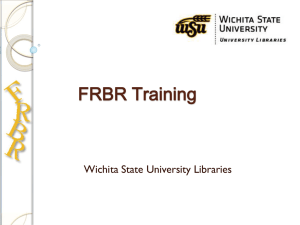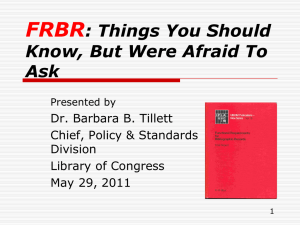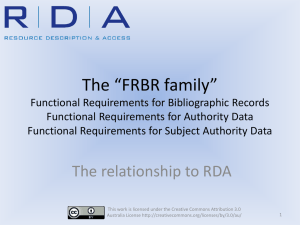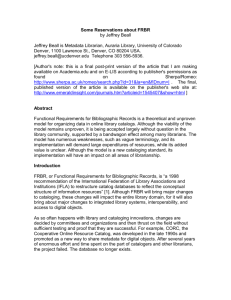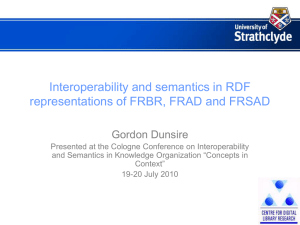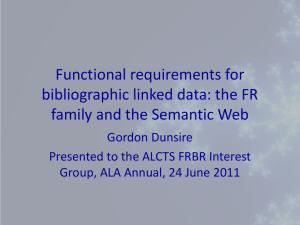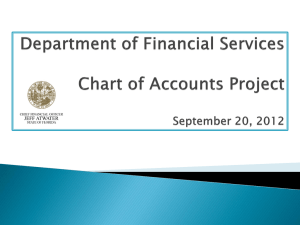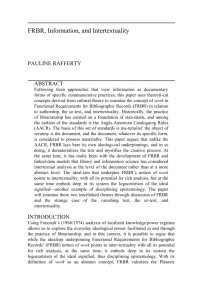FRBR Family
advertisement
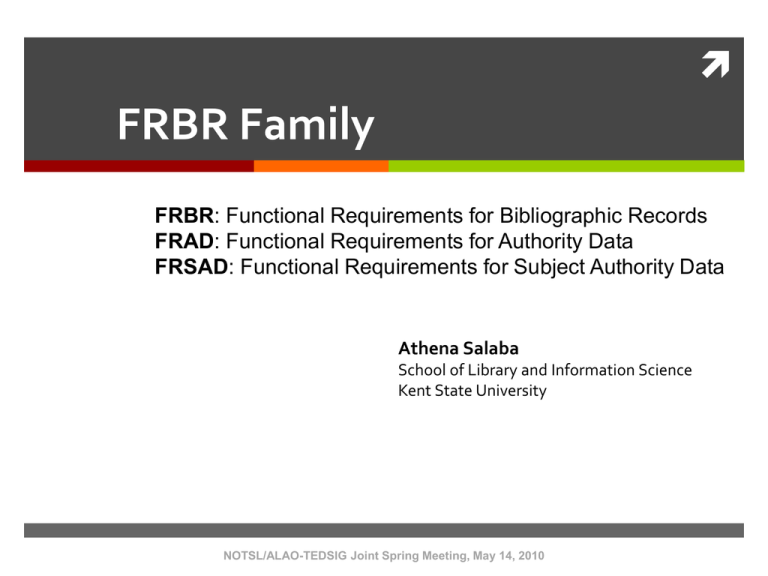
FRBR Family FRBR: Functional Requirements for Bibliographic Records FRBR: Functional Requirements for Bibliographic Records FRAD: Functional Requirements for Authority Data FRAD: Functional Requirements for Authority Data FRSAD: Functional Requirements for Subject Authority Data FRSAD: Functional Requirements for Subject Authority Data Athena Salaba School of Library and Information Science Kent State University NOTSL/ALAO-TEDSIG Joint Spring Meeting, May 14, 2010 FRBR: Functional Requirements for Bibliographic Records FRAD: Functional Requirements for Authority Data Original framework (approved 1997, published 1998) Defines all entities Focus on Group 1 entities FRANAR / FRAR (published June, 2009) Authority records Focus on Group 2 entities FRSAD: Functional Requirements for Subject Authority Data FRSAR Focus on Group3 entities Established April 2005 Draft Report released for comments (June 23, 2009); to be released summer 2010 NOTSL/ALAO-TEDSIG Joint Spring Meeting, May 14, 2010 The Bibliographic Universe Traditionally … Object oriented model Emphasis on the object containing a document/content AACR2 Part 1: Description 1. General 2. Books, Pamphlets, and Printed Sheets 3. Cartographic Materials 4. Manuscripts 5. Printed Music 6. Sound Recordings 7. Motion Pictures and Video recordings 8. Graphic Materials 9. Electronic Resources 10. Three-Dimensional Artefacts and Realia 11. Microforms 12. Continuing Resources 13. Analysis NOTSL/ALAO-TEDSIG Joint Spring Meeting, May 14, 2010 The Bibliographic Universe Should that be our primary focus? What do users really want? Solution: Content oriented model IFLA 1992: focus at functional requirements of library catalog records NOTSL/ALAO-TEDSIG Joint Spring Meeting, May 14, 2010 Functions of a Catalog Cutter’s Objects IFLA ICP: Objectives and Functions To enable a person to find a book of which either: To show what a library has the author is known (A) the title is known (B) the subject is known (C) by a given author (D) by a given subject (E) by a given kind of literature (F) To assist in the choice of as to the edition (bibliographically) (G) as to its character (literary or topical) (H) to find bibliographic resources in a collection as the result of a search using attributes or relationships of the resources: to find a single resource to find sets of resources representing to identify a bibliographic resource or agent to select a bibliographic resource that is appropriate to the user’s needs to acquire or obtain access to an item described NOTSL/ALAO-TEDSIG Joint Spring Meeting, May 14, 2010 FRBR: Functional Requirements for Bibliographic Records IFLA’s FRBR Working Group, 1992-1997 IFLA's Functional Requirements for Bibliographic Records (FRBR), Final Report, 1998. Available at: http://www.ifla.org/en/publications/functionalrequirements-for-bibliographic-records Archived website: http://www.ifla.org/VII/s13/frbr/frbr.htm NOTSL/ALAO-TEDSIG Joint Spring Meeting, May 14, 2010 What is FRBR? Conceptual model based on entity-attribute-relationship Attributes Attributes Entity 1 Relationship Entity 2 •Title •Creator User tasks •Topic Not a set of rules Not an implementation study/guide NOTSL/ALAO-TEDSIG Joint Spring Meeting, May 14, 2010 FRBR User Tasks Find (locate or collocate) entities that correspond to the user's stated search criteria (i.e., to locate either a single entity or a set of entities in a file or database as the result of a search using an attribute or relationship of the entity) Identify an entity (i.e., to confirm that the entity described corresponds to the entity sought, or to distinguish between two or more entities with similar characteristics) Select an entity that is appropriate to the user's needs (i.e., to choose an entity that meets the user's requirements with respect to content, physical format, etc., or to reject an entity as being inappropriate to the user's needs) Acquire or obtain access to the entity described (i.e., to acquire an entity through purchase, loan, etc., or to access an entity electronically through an online connection to a remote computer) (Functional Requirements for Bibliographic Records, 1998, p.82) Others??? Relate? Navigate? NOTSL/ALAO-TEDSIG Joint Spring Meeting, May 14, 2010 FRBR Entities Group 1: products of intellectual and artistic endeavor Group 2: those responsible for the intellectual & artistic content, physical production, or custodianship works expressions manifestations items persons corporate bodies Group 3: entities that serve as subjects of intellectual or artistic endeavor concepts objects events place NOTSL/ALAO-TEDSIG Joint Spring Meeting, May 14, 2010 FRBR Group 1 Entities Work Expression Manifestation Item Distinct intellectual or artistic creation, abstract Specific intellectual or artistic form that a work takes each time it is realized. The physical embodiment of an expression of a specific work. A single example of a manifestation. NOTSL/ALAO-TEDSIG Joint Spring Meeting, May 14, 2010 FRBR Group 1 Relationships primary relationships A Work is realized through an Expression Work Expression An Expression is embodied in a manifestation A Manifestation is exemplified by an Item An Expression realizes a Work A Manifestation embodies an Expression Manifestation Item An Item Exemplifies a Manifestation NOTSL/ALAO-TEDSIG Joint Spring Meeting, May 14, 2010 Work 1 Evolution, origin, species E1: Text- English E2: Text - German Origins of species Die Entstehung der Arten. Translated by Heinrich Schmidt M1 On the origin of species by means of natural selection. London, Murray,1859 M2 Η Καταγωγή των Ειδών. Translated by Πάγκαλος Ανδρέας M1 The Origin of species. Edited and read by Richard Dawkins. Abridged M1 Η Καταγωγή των Ειδών. Αθηνα, Γκοβόστης,20 07 Die Enstehung der Arten. The origin of species. New York, Gramercy, 1995 Leibzig, Kröner, 1884 M1 The origin of species London, CSA Wordp2008. 1 compact disc I1 New York PL Copy 1 E3: Text- Greek E4: Spoken word performance - English I2 Atheneum Copy 1 signed by author FRBR Group 2 Entities Person An individual deceased or living involved in the creation or realization of a work or are the subject of a work (about them). Corporate Body An organization or a group of individuals and/or a group of organizations acting as a unit involved in the creation or realization of a work or are the subject of a work. Families – added after the final report and in FRAD NOTSL/ALAO-TEDSIG Joint Spring Meeting, May 14, 2010 FRBR Group 2 Relationships to Group 1 Entities primary relationships • work is created by person or corporate body • expression is realized by person or corporate body • manifestation is produced by person or corporate body • item is owned by person or corporate body Examples: • the work “Origin of species” is created by Charles Darwin • the item is owned by Kent Free Library NOTSL/ALAO-TEDSIG Joint Spring Meeting, May 14, 2010 FRBR Group 3 Entities Concept An abstract notion or an idea as a subject of a work. E.g.: Economics, Agriculture, Library Science Object A material thing as a subject of a work. E.g.: Eiffel Tower, Challenger Event An action or occurrences (historical events, periods of time, etc.) as a subject of a work. E.g.: Civil War, 21st Century Place A location (terrestrial and extraterrestrial; historical and contemporary; geographic features and geopolitical jurisdictions as subjects of a work. E.g.: The Moon, Ohio, Howard Beach. In addition, all of Group 1 and Group 2 entities can be subjects of a work NOTSL/ALAO-TEDSIG Joint Spring Meeting, May 14, 2010 FRBR Group 3 Relationships to Group 1 entities primary relationships • A work has as subject an entity such as concept, object, event, place, person, corporate body, work, manifestation, expression, item • An entity of Group 1, 2, 3 is the subject of a work Examples: • The concept “evolution” is the subject of work 1 “Origin of species” • Work 1 “Origin of species” is the subject of work 2 “Darwin's garden” NOTSL/ALAO-TEDSIG Joint Spring Meeting, May 14, 2010 Entity Attributes Attributes of a Work title of the work form of work date of the work other distinguishing characteristic intended termination , etc. Attributes of an Expression title of the expression form of expression date of expression language of expression scale (cartographic image/object) projection (cartographic image/object), etc. (selective) Attributes of a Manifestation title of the manifestation statement of responsibility edition/issue designation place of publication/distribution publisher/distributor date of publication/distribution extent of the carrier physical medium dimensions of the carrier , etc. Attributes of an Item item identifier provenance of the item marks/inscriptions condition of the item , etc. NOTSL/ALAO-TEDSIG Joint Spring Meeting, May 14, 2010 Bibliographic Relationships FRBR – primary W is realized through E E is embodied in M M is exemplified by I is created by is realized by is produced by has as subject Typology (Tillett) Equivalence Derivative Descriptive Whole-part/Part-Whole Accompanying Sequential Shared characteristics NOTSL/ALAO-TEDSIG Joint Spring Meeting, May 14, 2010 Other relationships (beyond primary) Work-to-work (supplement, adaptation, …) Expression-to-expression (revision, translation, …) Expression-to-work (complement, summarization …) Manifestation-to-manifestation (reproduction, alternate) Manifestation-to-item (reproduction) Item-to-item (reconfiguration, reproduction) Whole/Part at work, expression, manifestation and item level NOTSL/ALAO-TEDSIG Joint Spring Meeting, May 14, 2010 FRBR Review FRBR Review WG Expression Aggregates, 2005 FRBR/CRM Dialogue, 2003: FRBR (FRBRoo) CIDOC Conceptual Reference Model (CRM) FRBR Namespace Project, 2007 NOTSL/ALAO-TEDSIG Joint Spring Meeting, May 14, 2010 FRAD: Functional Requirements for Authority Data IFLA UBCIM Working Group on Functional Requirements and Numbering of Authority Records (FRANAR) Goals: Provide an understanding of current authority data functions Clarify underlying concepts and provide a basis for refining and improving authority data practice Functional Requirements for Authority Data: A Conceptual Model (FRAD), 2009 NOTSL/ALAO-TEDSIG Joint Spring Meeting, May 14, 2010 FRAD: Functions of the Authority file Document decisions Serve as reference tool (cataloger) Control form of access points Support access to bibliographic file (end-user) Link bibliographic and authority records NOTSL/ALAO-TEDSIG Joint Spring Meeting, May 14, 2010 FRAD: Users and User Tasks Users of Authority Data Authority record creators and reference librarians Library users Authority Data User Tasks Find entities corresponding to stated criteria, or explore the universe of bibliographic entities Identify an entity as being the one sought, or to validate the form of name to be used as a controlled access point Contextualize place in context, clarify relationships between persons or person and names by which is known Justify Document the authority data creator’s reason for choosing the name or form of name on which a controlled access point is based NOTSL/ALAO-TEDSIG Joint Spring Meeting, May 14, 2010 FRAD Basics “Entities in the bibliographic universe (such as those identified in the Functional Requirements for Bibliographic Records) are known by names and/or identifiers. In the cataloguing process (whether it happens in libraries, museums, or archives), those names and identifiers are used as the basis for constructing controlled access points.” FRAD, p. 19 NOTSL/ALAO-TEDSIG Joint Spring Meeting, May 14, 2010 FRAD Model Entities Relationships PERSON FAMILY CORPORATE BODY WORK EXPRESSION associated with MANIFESTATION ITEM CONCEPT OBJECT EVENT PLACE known by NAME Figure 2 assigned IDENTIFIER NAME Figure 1 IDENTIFIER basis for ACCESS POINT AUTHORIZED HEADING registered as referenced from referenced from VARIANT HEADING AUTHORITY RECORD registered in registered in REFERENCE RECORD registered as EXPLANATORY HEADING registered in EXPLANATORY RECORD governed by RULES govern Created/modified by applied by created / transcribed / modified / issued by AGENCY FRAD Entities Person (Dates of Person, Title of Person, Place of birth, Language, Field of activity …) Name (Type of name, Scope of usage, Dates of usage, Language of name …) Controlled access point (Type of access point, Language of cataloguing, Source of access point …) Identifier (Type of identifier) Family (Type of family, Dates of family, History of family …) Corporate Body Work Expression Manifestation Item Concept Object Event Place Rules Agency NOTSL/ALAO-TEDSIG Joint Spring Meeting, May 14, 2010 FRAD Relationships Work Work Sequential relationship Derivative relationship Whole/part relationship Accompanying relationship …. Name of Person Name of Person Real name relationship Earlier name relationship Later name relationship … Controlled access point Controlled access point Parallel language relationship Alternate script relationship Different rules relationship NOTSL/ALAO-TEDSIG Joint Spring Meeting, May 14, 2010 FRSAD: Functional Requirements for Subject Authority Data FRSAR Terms of Reference FRSAR = Functional Requirements for Subject Authority Records to build a conceptual model of Group 3 entities within the FRBR framework as they relate to the aboutness of works, to provide a clearly defined, structured frame of reference for relating the data that are recorded in subject authority records to the needs of the users of those records, and to assist in an assessment of the potential for international sharing and use of subject authority data both within the library sector and beyond. NOTSL/ALAO-TEDSIG Joint Spring Meeting, May 14, 2010 FRSAD: Users of Subject Authority Data NOTSL/ALAO-TEDSIG Joint Spring Meeting, May 14, 2010 FRSAD: User Tasks Find one or more subjects and/or their appellations, that correspond(s) to the user’s stated criteria, using attributes and relationships; Identify a subject and/or its appellation based on their attributes or relationships (i.e., to distinguish between two or more subjects or appellations with similar characteristics and to confirm that the appropriate subject or appellation has been found); Select a subject and/or its appellation appropriate to the user’s needs (i.e., to choose or reject based on the user's requirements and needs); Explore relationships between subjects and/or their appellations (e.g., to explore relationships in order to understand the structure of a subject domain and its terminology). NOTSL/ALAO-TEDSIG Joint Spring Meeting, May 14, 2010 User Tasks in the FRBR-Family FRBR FRAD FRSAD Find Find Find a subject entity or entities Identify Identify an entity Identify Select Obtain Contextualize, place in context, explore relationships Justify the form of an access point Select Explore relationships, etc. ‘Issues’ with Group 3 How to subdivide (if at all)? Object, Concept, Event, Place Concrete/abstract Class/instance Other models NOTSL/ALAO-TEDSIG Joint Spring Meeting, May 14, 2010 Entities: Thema: any entity used as a subject of a work Nomen: any sign or sequence of signs (alphanumeric characters, symbols, sound, etc.) by which a thema is known, referred to or addressed NOTSL/ALAO-TEDSIG Joint Spring Meeting, May 14, 2010 WORK has as subject THEMA / THEMA is subject of WORK This model confirms one of the basic relationships defined in FRBR: WORK has as subjectTHEMA / THEMA is subject of WORK. Thema = "any entity used as a subject of a work". Thema includes any of the FRBR entities: Group 1 and Group 2 entities and, in addition, all other subjects of works. NOTSL/ALAO-TEDSIG Joint Spring Meeting, May 14, 2010 THEMA has appellation NOMEN / NOMEN is appellation of THEMA This model also proposes a new relationship: THEMA has appellation NOMEN / NOMEN is appellation of THEMA. • NOMEN = any sign or sequence of signs (alphanumeric characters, symbols, sound, etc.) by which a thema is known, referred to or addressed NOTSL/ALAO-TEDSIG Joint Spring Meeting, May 14, 2010 Hierarchical Partitive Generic Instance Associative Other thema-to-thema relationships are implementation-dependent NOTSL/ALAO-TEDSIG Joint Spring Meeting, May 14, 2010 Equivalence Equivalence can be specified further, e.g.: replaces/is replaced by has variant form/is variant form has derivation/is derived from has acronym/is acronym for has abbreviation/is abbreviation of has transliterated form/is transliteration of Partitive NOTSL/ALAO-TEDSIG Joint Spring Meeting, May 14, 2010 FRSAD Entity Attributes Thema Type Note Thema Type Implementation-specific: •FRBR: concept, object, event, place, Group 1, Group 2 •FAST: topical, names, geographics, periods, titles, events •UMLS: entities (physical, conceptual), events Nomen Type Scheme Reference source Represent ation Language Script Script conversion Form Time of validity Audience Status NOTSL/ALAO-TEDSIG Joint Spring Meeting, May 14, 2010 FRBR-Family Resources IFLA FRBR-Family, http://www.ifla.org/en/node/2016 FRBR, http://www.ifla.org/publications/functional- requirements-for-bibliographic-records FRBR Review Group, http://www.ifla.org/en/frbr-rg FRAD, http://www.ifla.org/publications/functional- requirements-for-authority-data FRSAD, http://www.ifla.org/node/1297 NOTSL/ALAO-TEDSIG Joint Spring Meeting, May 14, 2010 THANK YOU! Athena Salaba asalaba@kent.edu NOTSL/ALAO-TEDSIG Joint Spring Meeting, May 14, 2010
